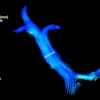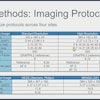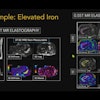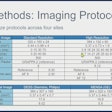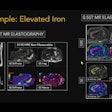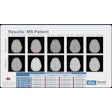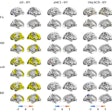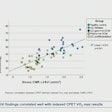A novel MRI technique called quantitative magnetization transfer (qMT) identifies changes in brain entropy due to normal aging, according to research to be presented May 14 at the International Society for Magnetic Resonance in Medicine (ISMRM) meeting.
The findings could help clinicians initiate preventive treatment in individuals who develop neurological disease as they age, wrote a team led by Sohae Chung, PhD, of New York University Grossman School of Medicine.
"Our demonstration of qMT brain entropy as a sensitive indicator of normal aging-associated changes throughout the brain provides a potential quantitative biomarker that can be utilized to detect underlying neurological conditions linked to aging, enabling timely intervention," it noted.
Identifying and tracking biomarkers of brain aging is key to understanding mechanisms of age-related changes that could indicate underlying neurological conditions, the group wrote. Compared to conventional brain MRI, qMT MRI (a technique that quantifies the exchange of magnetization between macromolecular proteins and water protons in tissues) is more sensitive for detecting tissue changes because it can access the "interaction between free and bound protons within macromolecules like neuronal cell membranes in gray matter and myelin in white matter," the investigators explained. The technique has been somewhat hindered by a lack of reproducibility and long exam times; Chung and colleagues explored whether the use of rapid hybrid-state qMT imaging could address these issues. They conducted the exams with 1-mm isotropic resolution and whole-brain coverage, then calculated brain entropy parameters.
Overall, the team reported "significant correlations" between entropy markers and age in cerebrospinal fluid and cortical gray matter, and between longitudinal relaxation rates entropy and age in cortical gray matter and white matter -- findings that support the idea that "aging can affect brain entropy, and this change is detectable with qMT imaging."
![Regions of interest depicted in colors: cerebrospinal fluid (blue), cortical gray matter (dark green), and white matter (yellow). Scatter plots present significant correlations between (b) [semi-solid spin pool size, or ms0m0s] entropy and age in cerebrospinal fluid and cortical gray matter, and (c) [longitudinal relaxation rates, or Rf1R1f] entropy and age in cortical gray matter and white matter (p < 0.05). Images, graphics, and caption courtesy of Sohae Chung, PhD, and the ISMRM.](https://img.auntminnie.com/mindful/smg/workspaces/default/uploads/2025/05/2025-05-09-novel-mri-technique-image.tmqDtL6pTg.png?auto=format%2Ccompress&fit=max&q=70&w=400) Regions of interest depicted in colors: cerebrospinal fluid (blue), cortical gray matter (dark green), and white matter (yellow). Scatter plots present significant correlations between (b) [semi-solid spin pool size, or ms0m0s] entropy and age in cerebrospinal fluid and cortical gray matter, and (c) [longitudinal relaxation rates, or Rf1R1f] entropy and age in cortical gray matter and white matter (p < 0.05). Images, graphics, and caption courtesy of Sohae Chung, PhD, and the ISMRM.
Regions of interest depicted in colors: cerebrospinal fluid (blue), cortical gray matter (dark green), and white matter (yellow). Scatter plots present significant correlations between (b) [semi-solid spin pool size, or ms0m0s] entropy and age in cerebrospinal fluid and cortical gray matter, and (c) [longitudinal relaxation rates, or Rf1R1f] entropy and age in cortical gray matter and white matter (p < 0.05). Images, graphics, and caption courtesy of Sohae Chung, PhD, and the ISMRM.
More research is needed, according to Chung's group.
"Future work includes identifying unique patterns of entropy changes in neurological conditions associated with aging and understanding the impact of aging on different diseases for early detection and intervention," they concluded.
Check out AuntMinnie.com’s full coverage of ISMRM 2025 here.

